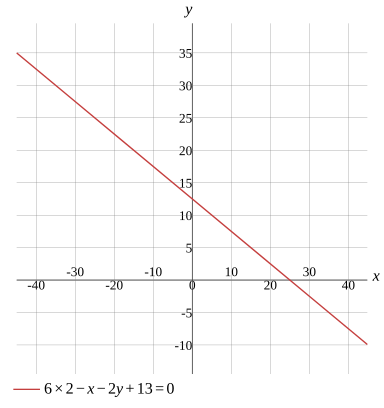Question
Function
Find the x-intercept/zero
Find the y-intercept
Find the slope
x=25
Evaluate
6×2−x−2y+13=0
To find the x-intercept,set y=0
6×2−x−2×0+13=0
Any expression multiplied by 0 equals 0
6×2−x−0+13=0
Simplify
More Steps


Evaluate
6×2−x−0+13
Multiply the numbers
12−x−0+13
Removing 0 doesn't change the value,so remove it from the expression
12−x+13
Add the numbers
25−x
25−x=0
Move the constant to the right-hand side and change its sign
−x=0−25
Removing 0 doesn't change the value,so remove it from the expression
−x=−25
Solution
x=25
Show Solution

Solve the equation
Solve for x
Solve for y
x=25−2y
Evaluate
6×2−x−2y+13=0
Simplify
More Steps


Evaluate
6×2−x−2y+13
Multiply the numbers
12−x−2y+13
Add the numbers
25−x−2y
25−x−2y=0
Rewrite the expression
25−2y−x=0
Move the expression to the right-hand side and change its sign
−x=0−(25−2y)
Subtract the terms
More Steps


Evaluate
0−(25−2y)
If a negative sign or a subtraction symbol appears outside parentheses, remove the parentheses and change the sign of every term within the parentheses
0−25+2y
Removing 0 doesn't change the value,so remove it from the expression
−25+2y
−x=−25+2y
Solution
x=25−2y
Show Solution

Testing for symmetry
Testing for symmetry about the origin
Testing for symmetry about the x-axis
Testing for symmetry about the y-axis
Not symmetry with respect to the origin
Evaluate
6⋅2−x−2y+13=0
Simplify the expression
25−x−2y=0
To test if the graph of 25−x−2y=0 is symmetry with respect to the origin,substitute -x for x and -y for y
25−(−x)−2(−y)=0
Evaluate
More Steps


Evaluate
25−(−x)−2(−y)
Multiply the numbers
25−(−x)+2y
If a negative sign or a subtraction symbol appears outside parentheses, remove the parentheses and change the sign of every term within the parentheses
25+x+2y
25+x+2y=0
Solution
Not symmetry with respect to the origin
Show Solution

Rewrite the equation
Rewrite in polar form
Rewrite in standard form
Rewrite in slope-intercept form
r=cos(θ)+2sin(θ)25
Evaluate
6×2−x−2y+13=0
Evaluate
More Steps


Evaluate
6×2−x−2y+13
Multiply the numbers
12−x−2y+13
Add the numbers
25−x−2y
25−x−2y=0
To convert the equation to polar coordinates,substitute x for rcos(θ) and y for rsin(θ)
25−cos(θ)×r−2sin(θ)×r=0
Factor the expression
(−cos(θ)−2sin(θ))r+25=0
Subtract the terms
(−cos(θ)−2sin(θ))r+25−25=0−25
Evaluate
(−cos(θ)−2sin(θ))r=−25
Solution
r=cos(θ)+2sin(θ)25
Show Solution

Find the first derivative
Find the derivative with respect to x
Find the derivative with respect to y
dxdy=−21
Calculate
6⋅2−x−2y+13=0
Simplify the expression
25−x−2y=0
Take the derivative of both sides
dxd(25−x−2y)=dxd(0)
Calculate the derivative
More Steps


Evaluate
dxd(25−x−2y)
Use differentiation rules
dxd(25)+dxd(−x)+dxd(−2y)
Use dxd(c)=0 to find derivative
0+dxd(−x)+dxd(−2y)
Evaluate the derivative
More Steps


Evaluate
dxd(−x)
Use differentiation rule dxd(cf(x))=c×dxd(f(x))
−dxd(x)
Use dxdxn=nxn−1 to find derivative
−1
0−1+dxd(−2y)
Evaluate the derivative
More Steps


Evaluate
dxd(−2y)
Use differentiation rules
dyd(−2y)×dxdy
Evaluate the derivative
−2dxdy
0−1−2dxdy
Evaluate
−1−2dxdy
−1−2dxdy=dxd(0)
Calculate the derivative
−1−2dxdy=0
Move the constant to the right-hand side and change its sign
−2dxdy=0+1
Removing 0 doesn't change the value,so remove it from the expression
−2dxdy=1
Change the signs on both sides of the equation
2dxdy=−1
Divide both sides
22dxdy=2−1
Divide the numbers
dxdy=2−1
Solution
dxdy=−21
Show Solution

Find the second derivative
Find the second derivative with respect to x
Find the second derivative with respect to y
dx2d2y=0
Calculate
6⋅2−x−2y+13=0
Simplify the expression
25−x−2y=0
Take the derivative of both sides
dxd(25−x−2y)=dxd(0)
Calculate the derivative
More Steps


Evaluate
dxd(25−x−2y)
Use differentiation rules
dxd(25)+dxd(−x)+dxd(−2y)
Use dxd(c)=0 to find derivative
0+dxd(−x)+dxd(−2y)
Evaluate the derivative
More Steps


Evaluate
dxd(−x)
Use differentiation rule dxd(cf(x))=c×dxd(f(x))
−dxd(x)
Use dxdxn=nxn−1 to find derivative
−1
0−1+dxd(−2y)
Evaluate the derivative
More Steps


Evaluate
dxd(−2y)
Use differentiation rules
dyd(−2y)×dxdy
Evaluate the derivative
−2dxdy
0−1−2dxdy
Evaluate
−1−2dxdy
−1−2dxdy=dxd(0)
Calculate the derivative
−1−2dxdy=0
Move the constant to the right-hand side and change its sign
−2dxdy=0+1
Removing 0 doesn't change the value,so remove it from the expression
−2dxdy=1
Change the signs on both sides of the equation
2dxdy=−1
Divide both sides
22dxdy=2−1
Divide the numbers
dxdy=2−1
Use b−a=−ba=−ba to rewrite the fraction
dxdy=−21
Take the derivative of both sides
dxd(dxdy)=dxd(−21)
Calculate the derivative
dx2d2y=dxd(−21)
Solution
dx2d2y=0
Show Solution

Graph
